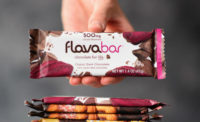Barry Callebaut Group has identified trends it predicts will influence chocolate creations and new product launches this year and beyond.
During a Jan. 28 presentation of BC LIVE, the group’s digital event and education platform, Charlotte Green, market segment developer for confectionery, North America, highlighted four themes set to impact the chocolate space. They include:
- Indulgent Moments
- Taking New Forms
- Good for Me
- Chocolate I Trust
Green pointed to consumers seeking comfort in indulgent moments during the COVID-19 pandemic, along with other occasions for consuming chocolate.
“We know that comfort food has become more important, and of course, chocolate has a role to play there in terms of supporting consumers’ emotional well-being,” she said. “Whether it is comfort or finding moments to celebrate … this will continue as restrictions get lifted. They’ll still be looking for ways to celebrate and also looking for ways to escape the ordinary.”
Barry Callebaut noted 71 percent of North American consumers want to try new and exciting chocolate experiences, such as the hot chocolate bombs that have taken over TikTok and other social media platforms.
The company also reported more than half (55 percent) of North American consumers say rare and unique flavors make chocolate more exciting. Green pointed to “super dark” chocolate with high cacao percentages, dark milk chocolate and Barry Callebaut’s Ruby chocolate.
To illustrate indulgent moments, Chef Gabrielle Draper, lead - R&D technical culinary applications, demonstrated making a layered countline featuring dark milk chocolate ganache — made with Barry Callebaut’s Accent Dark Milk Chocolate — graham cracker pieces and marshmallow.
As for Taking New Forms, Green noted the lines continue to blur between treating and snacking.
“This is really driven by the fact there are so many more at-home snacking occasions as consumers are having to spend more time at home,” she said. “That shift has meant we’ve seen real creativity in the new snacks that are on offer.”
Citing research from Euromonitor and Innova Market Insights, Barry Callebaut noted 58 percent of U.S. consumers claim to be snacking more since the start of the COVID-19 pandemic. Because of this, chocolate packed in bags and pouches is poised to grow 3.2 percent over the next five years.
Consumers are also seeking multi-sensorial experiences, and as a result, launches of chocolate confections launched with “crispy” and “crunchy” texture have increased by 50 percent over the last five years.
Green also covered recent product introductions that feature chocolate in unexpected ways, such as Reese’s Snack Cakes, Kween Chocolate Granola Butter and Spicy Maya Dry Irish Stout, a collaboration between Chuao Chocolatier and Thorn Brewing.
Highlighting the bridge between chocolate and snacking, Martin Diez, lead chef of BC Studio, demonstrated a trail mix featuring granola pieces, peanuts, gold chocolate pieces and peanut butter cups.
While consumers have been increasingly seeking better-for-you options, the coronavirus pandemic has only heightened their interest in products that support their health goals, Green noted.
“Consumers are really concerned about what they’re putting in their bodies and really being mindful of their health, while they still want a treat, of course,” she said. “We know tasting really good as well as being good for them is important.”
Green pointed to the movement of once-niche dietary lifestyles — such as vegan, paleo and keto — into the mainstream, especially in North America.
This has also been reflected in recent product launches. Citing data from Mintel, Barry Callebaut said there has been a 23 percent increase in snack bar and chocolate confectionery launches with the claims of vegan or no animal products over the last couple years.
Chocolate products made with plant-based “milks,” such as almond and oat milk, are also hitting the market.
“We’re seeing more brands are branding it as vegan,” Green said. “We’re also seeing those non-dairy options expanding into new spaces.”
Sales of sugar-free products also remain strong. Citing data from IRI, Barry Callebaut reported a 46 percent increase in sugar-free chocolate in the year ending Nov. 1, 2020.
Protein content is also a main concern, with 44 percent of U.S. bar consumers saying protein is an important factor in their purchasing decisions. Meanwhile, close to half of U.S. bar consumers look for products with 5-14 grams of protein.
Green noted Barry Callebaut has a variety of new offerings to meet these demands, such as dairy-free and milk-like chocolate and inclusions, nut butters, protein chips and coatings, and low-sugar and no sugar added chocolate. And to demonstrate these trends, Draper created a plant-based bon bon made with hazelnut praline and Barry Callebaut’s Plant Craft milk-like chocolate.
In addition to dietary concerns, sustainability is also top of mind, thanks in part to supply chain disruptions caused by the COVID-19 pandemic. Product shortages have prompted North American consumers to think more about brand transparency and where their food originates, Green said.
“We know that cocoa has really been in the spotlight from a sustainability perspective. Whether it’s in the consumer press or in Washington D.C., it’s really getting a lot of attention right now,” she said. “Consumers want to make sure they can indulge without harming the people or the planet.”
Green noted providence also plays a role in communicating quality. Citing data from the National Confectioners Association and Barry Callebaut’s 2019 proprietary study, the company reported 34 percent of North American chocolate consumers say European-made chocolate is better, versus 19 percent for American-made chocolate. Additionally, 6 in 10 North American consumers say replacing regular chocolate with Belgian chocolate will make it more premium.
In terms of single-origin chocolate, 25 percent of U.S. premium chocolate consumers have a preference for country or region for sourcing cacao.
“They’re really looking for a specific flavor, a bit like wine. The same is becoming true in chocolate as well,” Green said.
Transparency is also becoming more important, with half of U.S. consumers saying they value transparency in a confection’s ingredient sourcing, production and brand. Nearly 40 percent say their purchases are influenced by transparency.
Green highlighted Lidl’s new chocolate bars, made with cocoa sourced from the Kuapa Kokoo cooperative in Ghana, as well as the launch of GoodSam, a new brand focused on supporting farmers.
To fulfill these trends, Barry Callebaut offers Belgian and now Swiss chocolate, as well as single-origin chocolate. The company also works with Rainforest Alliance and Fairtrade, in addition to continuing its Cocoa Horizons sustainability program.
Diez rounded out the presentation by demonstrating a moulded duo cluster, made with Barry Callebaut’s Swiss milk and white chocolates, U.S. cranberries and California almond buttercrunch.





